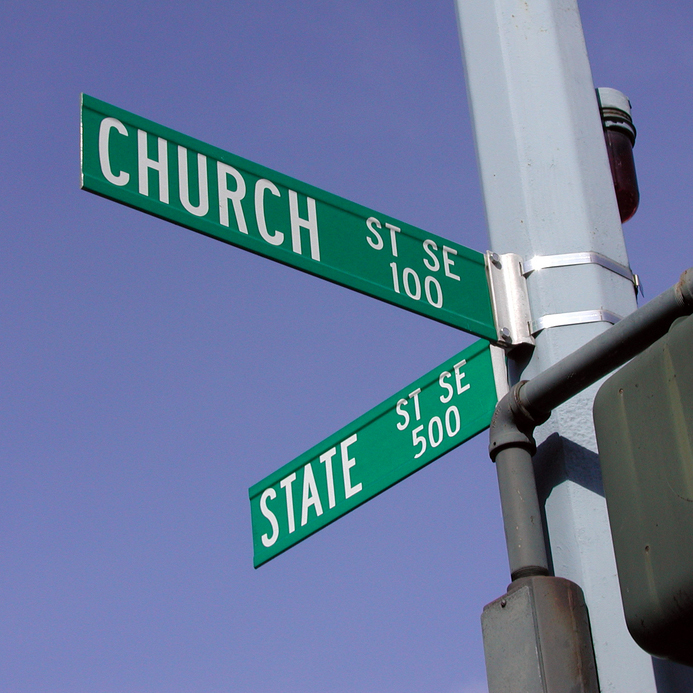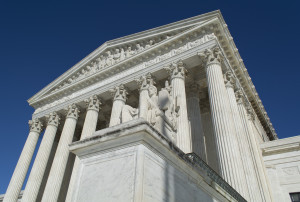Mission & History
The BJC’s mission is to defend and extend God-given religious liberty for all, furthering the Baptist heritage that champions the principle that religion must be freely exercised, neither advanced nor inhibited by government.
Church-State Separation
 The separation of church and state, or the “wall of separation” talked about by colonial Baptist Roger Williams, American leader Thomas Jefferson and the U.S. Supreme Court, is simply shorthand for expressing a deeper truth: religious liberty is best protected when church and state remain institutionally separated and neither tries to perform or interfere with the essential mission and work of the other.
The separation of church and state, or the “wall of separation” talked about by colonial Baptist Roger Williams, American leader Thomas Jefferson and the U.S. Supreme Court, is simply shorthand for expressing a deeper truth: religious liberty is best protected when church and state remain institutionally separated and neither tries to perform or interfere with the essential mission and work of the other.
For many Baptists, religious liberty is tied to the notion of “soul freedom,” which each individual receives as a gift from God. For others, it is tied to freedom of conscience. Church-state separation is the means of protecting these personal liberties.
Religious liberty in the United States of America is protected by the First Amendment’s two religion clauses, found in the first 16 words of the First Amendment of the U.S. Constitution’s Bill of Rights, which became law in 1791:
“Congress shall make no law respecting an establishment of religion, or prohibiting the free exercise thereof;”
These twin guarantees — free exercise of religion and no establishment of religion — have shaped the relationship between institutions of government and religion throughout our history, and their meaning has been developed by decisions of the U.S. Supreme Court. The First Amendment is binding upon the states, in addition to the federal government, by virtue of the Constitution’s 14th Amendment.
Commitment of Baptists and Founders to Religious Liberty
Baptists became champions of religious liberty and church-state separation in large measure because we are a people of the Book. For many, religious liberty is well-grounded in Scripture. Its taproot runs deep into the creation accounts in Genesis. The creation of human beings in God’s own image necessarily implies a freedom on our part to choose for or against a relationship with God, voluntarily and without coercion.
The Bible does not articulate a full-blown doctrine of the separation of church and state. Yet, its seeds are clearly present. Jesus at least foreshadowed the concept when he said “[g]ive therefore to the emperor things that are the emperor’s, and to God the things that are God’s” (Matthew 22:21). Jesus’ behavior was consistent with his words. He never took a coin from Caesar or sought the help of Herod in his ministry and mission. And, in many places, the New Testament outlines the contours of the separate realms of the kingdom of God and the kingdom of Caesar. The church is given the tasks of spreading the gospel (Acts 1:8), teaching doctrine (Matthew 28:20), and discipling believers (Ephesians 4:11-13). The state is divinely ordained to resist evil (Romans 13:3) and keep order (I Peter 2:13-15). Although these realms sometimes overlap and do not necessarily clash, the New Testament bears witness to a two-kingdom world — each with separate duties and each engendering different loyalties.
The separation of church and state does not require a banishment of religion from public life. In fact, colonial Baptist leaders John Leland and Isaac Backus, for all of their insistence upon the principle of separation, were thoroughly involved in public policy debates and attempts to influence legislation in their day.
Baptists often credit Roger Williams’ reference to a “hedge or wall of separation between the garden of the church and the wilderness of the world” as one of the earliest usages of the metaphor. Williams was expelled from the Massachusetts Bay Colony for preaching and teaching “soul freedom,” the enduring Baptist notion that faith cannot be dictated by any civil authority but must be expressed directly between the believer and God.
Early writings by the Founders demonstrate a commitment to church-state separation as well. Thomas Jefferson’s 1802 Letter to the Danbury Connecticut Baptist Association, in which he talked about his “sovereign reverence” for the wall of separation between religion and government, is one example. There are also important writings by the father of our Constitution, James Madison, who observed in 1819 that ” the number, the industry, and the morality of the Priesthood, & the devotion of the people have been manifestly increased by the total separation of the Church from the State.”
Supreme Court and Religious Liberty
 The U.S. Supreme Court has also shaped our modern understanding of the religion clauses through more than 200 years of jurisprudence interpreting and applying the Constitution. In a landmark 1947 religious liberty decision, Everson v. Board of Education of the Township of Ewing, NJ, Justice Hugo Black wrote one of the most famous passages describing the separation of church and state as embodied in the First Amendment:
The U.S. Supreme Court has also shaped our modern understanding of the religion clauses through more than 200 years of jurisprudence interpreting and applying the Constitution. In a landmark 1947 religious liberty decision, Everson v. Board of Education of the Township of Ewing, NJ, Justice Hugo Black wrote one of the most famous passages describing the separation of church and state as embodied in the First Amendment:
The “establishment of religion” clause of the First Amendment means at least this: Neither a state nor the Federal Government can set up a church. Neither can pass laws which aid one religion, or prefer one religion over another. . . . No person can be punished for entertaining or professing religious beliefs or disbeliefs. . . . Neither a state nor the Federal Government can, openly or secretly, participate in the affairs of any religious organizations or groups and vice versa. In the words of Jefferson, the clause against establishment of religion by law was intended to erect “a wall of separation between church and state.
At the same time, the Supreme Court has emphasized that the separation of church and state does not mean government can never accommodate religion or that government must regard religion with hostility. In Walz v. Tax Commission of City of New York (1970), the Court wrote that aside from “expressly proscribed governmental acts, there is room for play in the joints productive of a benevolent neutrality which will permit religious exercise to exist without sponsorship and without interference.” And in a 2005 case striking down a Ten Commandments display on government property, Justice Sandra Day O’Connor wrote,
[T]he goal of the [Religion] Clauses is clear: to carry out the Founders’ plan of preserving religious liberty to the fullest extent possible in a pluralistic society. By enforcing the Clauses, we have kept religion a matter for the individual conscience, not for the prosecutor or bureaucrat. At a time when we see around the world the violent consequences of the assumption of religious authority by government, Americans may count themselves fortunate: Our regard for constitutional boundaries has protected us from similar travails, while allowing private religious exercise to flourish.
Separating the institutions of church and state protects both. For each to do its work, there must always be a decent distance, between the two — some “swingin’ room,” to use preacher Gardner Taylor‘s phrase. The institutional and functional separation of church and state has resulted in a vibrant religion, a plush pluralism and a flourishing democracy. History teaches and contemporary geo-politics reveals that nations that abjure a healthy separation of church and state wind up with tepid, attenuated, majoritarian religion, at best, or a theocracy, at worst.




